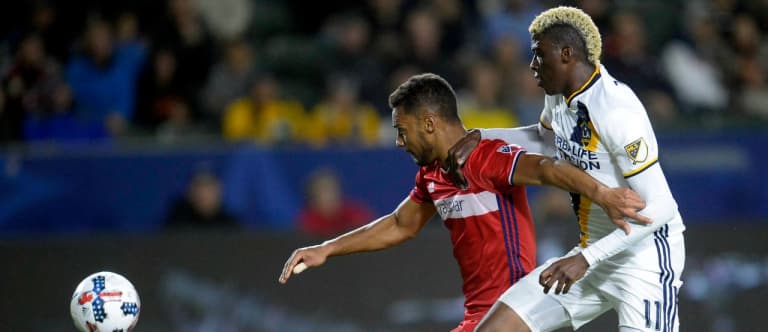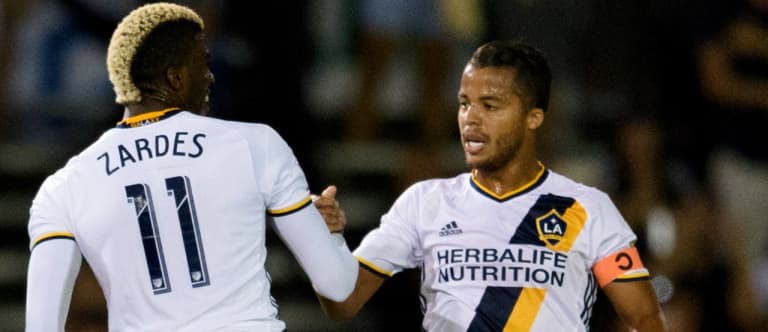It’s been 269 days and 607 game minutes since Gyasi Zardes felt the sweet relief of a goal. And he’s never needed one more than he does right this moment.
There have perhaps been more perplexing career trajectories bathed more deeply in shadow than Zardes’, but the number is notably small. In 2013, Zardes was a triumph of the burgeoning Homegrown system. In 2014, a breakout star. In 2015, an intriguing project on the wing slowly slipping in productivity. In 2016, a positional nomad ripped by injury in need of a rebirth.
And in 2017? The question is open-ended.
Zardes’ career was given over to paroxysms of hyperbole in 2014, when it seemed he was morphing into an athletic poacher for the national team before us. He scored 16 goals for the LA Galaxy that year, finished sixth in the league’s Golden Boot race and launched into 2015 with then-USMNT coach Jurgen Klinsmann’s blessing. He scored three USMNT goals that year, each of escalating concern: first in a friendly against the Netherlands, then in a Gold Cup match against Cuba and finally against St. Vincent and the Grenadines in 2018 World Cup qualifying. All in the span of five months.
Things have slowed since then, inviting a surprising amount of criticism onto a player whose true position is still a point of debate and who’s nonetheless managed to score six goals in each of the last two MLS seasons. The excitement came from those 16 goals. And the sharp spears appeared following what came after.
To help refine the question of what Zardes is, tactically, and perhaps what he can be, I think it helps to look at what he’s been.
Right now, Zardes has 32 career MLS goals in a little more than four seasons. Of those, 28 were scored as either the lone forward peg in a 4-2-3-1 or, as was far more often the case under then-LA Galaxy coach Bruce Arena, as one of the two strike partners in a 4-4-2. Zardes has obviously played far fewer games as a winger, which can partially help explain why he’s only scored four goals from wide positions in his pro career. But for me, the matter revolves less around how many he’s scored as a winger, and more in how he’s scored them.

Zardes’ first goal as a wide player in his pro career came on Aug. 9, 2015, mere days after Giovani dos Santos made his club debut as the new primary partner up top for Robbie Keane. Zardes scored one more from a wide position that year, and matched the effort identically in 2016. In both seasons he scored six goals, and in both he had four as a striker and two as a winger.
But the way he scored those goals relayed a cautionary tale. On all four career goals he’s scored while arrayed wide – two on the left, two on the right – he took precisely one touch on each of them. All four were poachers’ efforts in and around the six-yard box. His national team career is the same story. He’s scored six goals for the USMNT. All six came off a single touch from close range. Every. Single. One.
This is not how wingers operate, primarily because Zardes is not a winger. He’s a forward drawn inexorably toward the six-yard box like nickel pulled toward a magnet.
The truth is, Zardes is both the beneficiary and a victim of circumstance on the club level, which ripped his career from one extreme to the other. In 2014, Zardes reaped the benefits of Keane’s heightened defensive scrutiny to score 16 goals as a proper No. 9. Keane sucked defenders into his orbit like a supermassive black hole, and Zardes became unnaturally adept at reading and reacting to those orbital patterns. This goal, to me, is vintage Ideal Zardes, and it doesn’t happen without Keane drawing defensive attention to himself, dropping deep and then facilitating the remains.
See how Zardes moves as the No. 9 here? He’s not dipping into the box from a wide position, not running at a defender, not trying to stretch width, not even crossing for someone else. In truth, he’s more of a hammer than a feather if left to his strongest devices. This is how Zardes became the league’s sixth-leading scorer in 2014. He was essentially a box-bound Ramdeuter, a Thomas Muller-like space investigator feeding off slivers of daylight. That his career average on touches during goal sequences from wide positions is literally 1.0 should tell you everything you need to know about where he feels most comfortable.
You simply can’t push Zardes into wide space with a ball at his feet and expect him to take on defenders, tease out width and lace in crosses. He’s not particularly good at any of those things, and he’s being yanked away from the one thing he does superbly well; sense space and finish from buckshot range with devastating one-touch goals.
The other side of circumstance was the arrival of dos Santos. As good as Zardes had been up top, dos Santos couldn’t play wide, and Zardes was shunted into that position on occasion out of necessity. To watch him there was to watch a child banished to detention see his friends playing from the other side of a glass pane. From the start of his career up through the moment dos Santos arrived in LA, Zardes had 23 goals. He’s had nine since, a run that included a lengthy layoff due to a foot injury at the back end of 2016. He only just returned on April 1.
Part of the recent awkwardness is down to a relative organizational awkwardness on the part of a transitioning Galaxy. Landon Donovan left, which kicked out an incomparably huge pillar of the attack, and Keane wasn’t far behind. In the meantime, Zardes continually wants to come inside, away from the more uncomfortable jet stream along the flanks and closer to the warming brazier in the box he knows so well. And even then, he’s a streaky scorer at a streaky position.
Dos Santos is a lot of things, but he’s not a facilitator-striker like Keane was. And that’s had its effect on Zardes’ scoring volume.

Many of LA’s problems earlier in 2017 rotated around their creatively soft central midfield, which had an obvious knock-on effect for Zardes. Joao Pedro and Jermaine Jones were a relatively ineffective 4-4-2 partnership in the chance creation department, and it wasn’t until Curt Onalfo bumped dos Santos off the front line and back behind Zardes in a 4-2-3-1 that the attack opened and the wins started rolling in. It hasn’t necessarily benefitted Zardes in the scoring column, but I doubt you’ll hear him complain as the Galaxy ship stabilizes after a recent spate of withering storms.
The reality is that while I don’t think Zardes is reaching the height of his current promise, he’s closer than most allow because his ceiling is lower than most first assumed. His 2014 was a brilliant flash of light, but it was also blinding and anomalous. Whether knowingly or not, he’s being graded well off the fat part of the career production curve and into the extremities. I think it’s fair to expect Zardes to bag somewhere between 6-10 goals per year, and he’s currently on the low end of that scale. I don’t think even Zardes would argue that he’d like to be more productive up top. But he also arrived with such jarring suddenness in 2014 that he invited all manner of expectation into his career, and very little of it was either realistic or even plausible.
Zardes is 25, which isn’t as young as it may seem. He’ll continue to get his chances for the USMNT with former boss Arena at the rudder, and the coach said earlier this year he sees Zardes as a wide player for the national team while allowing that Zardes “will likely play the No. 9 position for the Galaxy this season.” Zardes is not a midfielder. He’s not a winger. He’s a forward, a space-investigating No. 9.
But much like the overstated expectation once placed on his career, I suppose that’ll continue to be a point of some debate stretching out across the horizon line.












